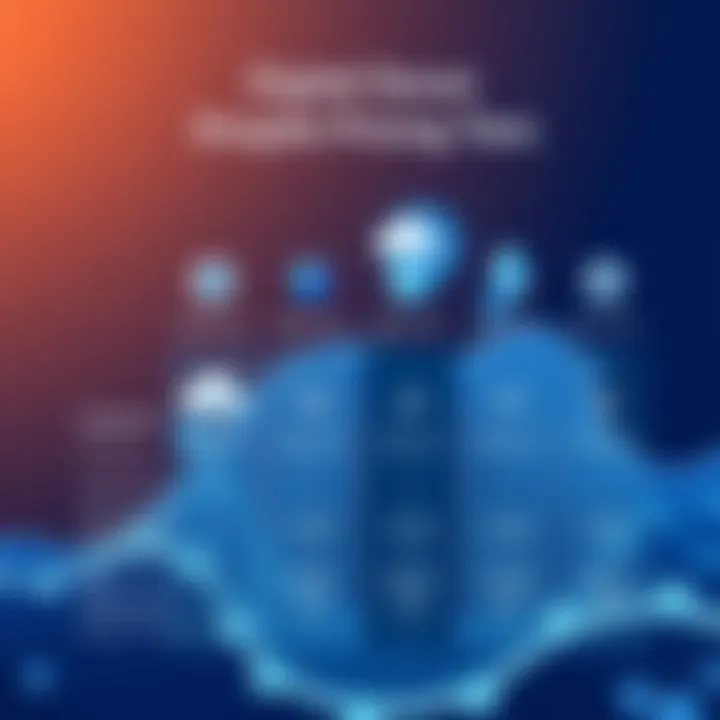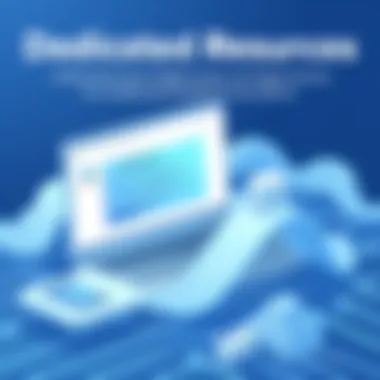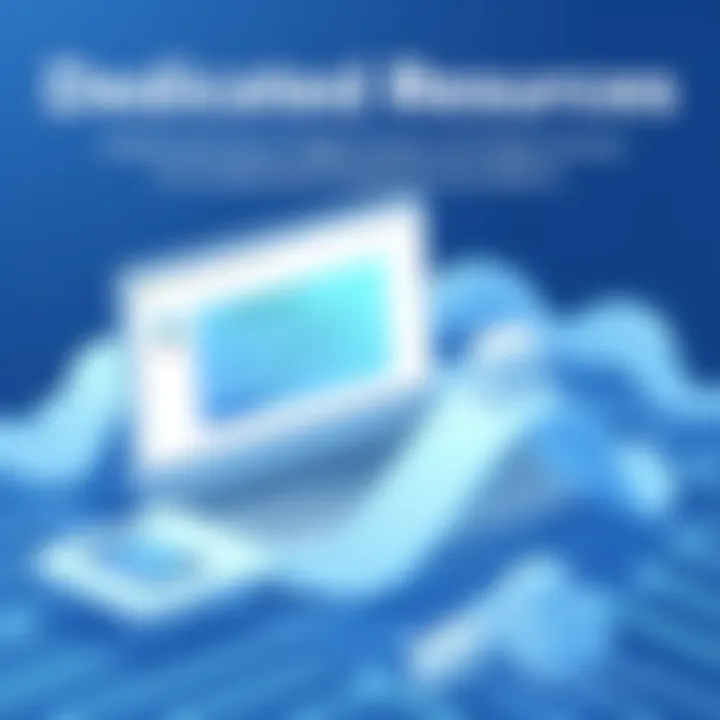Understanding Digital Ocean Droplet Pricing Options


Intro
In today’s fast-paced digital world, small to medium-sized businesses, entrepreneurs, and IT professionals are consistently on the lookout for reliable and cost-effective cloud solutions. Among the plethora of options available, Digital Ocean is a significant contender, offering droplets—virtual servers that can be tailored to suit various needs. But how does one navigate the pricing landscape of these droplets?
This guide aims to dissect Digital Ocean’s droplet pricing in detail. The focus will be on understanding the intricacies of cost factors and the different plans available, while also illuminating aspects such as dedicated resources and potential hidden expenses. By the end of this guide, readers will be equipped with the knowledge to make informed decisions about their cloud services, and we'll look into how Digital Ocean stacks up against its competitors.
Through careful budgeting tips and strategic recommendations, you’ll grasp everything you need to know before making your final choice.
Understanding Digital Ocean Droplets
In the ever-evolving landscape of cloud computing, grasping the concept of Digital Ocean Droplets is essential. Droplets serve as the backbone for deploying applications smoothly and efficiently. Understanding their structure and pricing is not just about costs; it's about harnessing flexible solutions tailored for diverse workloads. Whether you're a small business in need of reliable infrastructure, or a startup aiming to scale without breaking the bank, knowing how to navigate the world of Droplets can make a substantial difference in your overall strategy.
Definition of Droplets
Droplets are essentially virtual machines that run on Digital Ocean's cloud platform. Each Droplet is a slice of a physical server, tailored to run applications, websites, or any workloads users need. It’s important to note that each Droplet can be configured with various resources, which can include CPU, memory, and storage options. This adaptability allows users to ensure that they are only paying for the resources they truly require. It's a straightforward yet powerful concept that translates into significant benefits in both performance and cost management.
Types of Droplets
When it comes to Digital Ocean, the variety of Droplets available offers users a perfect match for their needs. Each type has its own advantages, and understanding these differences is fundamental for any effective budgeting or planning.
Standard Droplets
Standard Droplets are generally the go-to choice for most users. These Droplets provide a balanced set of resources suitable for hosting web applications, blogs, or any basic workload. One of the key characteristics that make Standard Droplets so appealing is their affordability. Many find them budget-friendly, which is often a substantial factor for startups and small businesses.
However, it’s worth noting that while they are reliable for everyday applications, they may not perform as well with high-complexity tasks. This could limit future scalability for some users, so understanding your application needs is crucial before settling on these.
General Purpose Droplets
General Purpose Droplets offer a more versatile resource allocation compared to their standard counterparts. This type is designed for workloads requiring a balanced mix of CPU and memory. A distinguishing feature of General Purpose Droplets is the ability to maintain steady performance during unpredictable traffic spikes. This comes in handy for businesses that operate e-commerce sites or applications that might experience variations in demand.
While these might come at a higher cost than Standard Droplets, the predictability in peformance is invaluable when uptime is paramount.
CPU-Optimized Droplets
As the name implies, CPU-Optimized Droplets are tailored for high-performance computing tasks. They focus on providing greater processing power, making them ideal for compute-intensive applications like large-scale data analysis or machine learning tasks. The major advantage of these Droplets is their capacity to handle workloads that demand high CPU usage without faltering.
However, if your applications are more I/O bound rather than CPU intensive, these might represent an overinvestment. Users should carefully assess if their workloads justify the extra costs associated with this type.
Memory-Optimized Droplets
When dealing with memory-intensive applications, Memory-Optimized Droplets come into play. These are particularly beneficial for tasks such as database management, caching, or running large applications that require significant RAM. The key selling point is the higher RAM allocation compared to other droplet types, ensuring that applications run smoothly without hiccups due to memory constraints.
That said, it’s essential to keep in mind that if your workload does not require extensive memory, the increased expenses could bring diminishing returns. Hence, evaluating your specific needs will save potential overspending.
In this digital age, making informed choices about Droplets can shape the efficiency and cost-effectiveness of your cloud experience.
Pricing Plans Overview
When considering a cloud service provider like Digital Ocean, understanding the pricing plans is crucial. Potential users need clarity on what each plan offers and how it fits into their budgeting strategy. Digital Ocean’s pricing structure is straightforward, yet it contains nuances that could significantly impact the overall cost for businesses, especially small to medium-sized enterprises and startups.
The significance of this section lies in its ability to demystify the pricing landscape. It highlights different plans tailored to various needs, allowing users to make informed decisions based on their specific use cases. Understanding the pricing plans can prevent unexpected expenses and help in optimizing performance-to-cost ratios.
Basic Pricing Structure
Digital Ocean follows a clear, yet flexible pricing strategy. The fundamental aspect is that the prices are based on resource allocation, which means users pay for what they use. Here, it's essential to appreciate how this structure encourages more careful resource management.
Most notably, each Droplet falls into distinct categories, primarily influenced by their resource specifications:
- Standard Droplets: Ideal for general applications and websites.
- General Purpose Droplets: A step up for more demanding workloads, blending performance and price.
- CPU-Optimized Droplets: Tailored for CPU-intensive applications.
- Memory-Optimized Droplets: Focused on memory-heavy tasks to ensure smooth performance.
The straightforward nature of Digital Ocean’s pricing makes it easier for businesses to estimate monthly budgets and predict spending. But keep in mind, as you scale up resources, costs will also ramp up. Consequently, this basic pricing framework aids users in estimating their financial commitments effectively.


Hourly vs Monthly Billing
One of the remarkable features of Digital Ocean’s pricing is the option between hourly and monthly billing. This flexibility allows users to tailor their payment structure based on their project needs, which is pivotal for businesses with varying workloads.
- Hourly Billing: This is well-suited for short-term projects or testing purposes. You get charged only for the hours the Droplet is active, providing flexibility to scale resources up or down without locking in fixed costs.
- Monthly Billing: Perfectly aligned for long-term projects, this model gives users predictability in their expenditures. For businesses with steady workloads, committing to a monthly plan often brings cost savings and consistent budgeting.
Choosing between hourly and monthly billing depends on project requirements. For instance, if your application sees fluctuating usage, hourly billing may save money in the long run. However, for those with predictable workloads, opting for monthly might yield better value.
In sum, this section breaks down the foundational elements of Digital Ocean’s pricing structure and billing options, giving readers a clear pathway to deciphering costs and planning their budget effectively. This insight is invaluable for anyone looking to integrate Digital Ocean into their business operations.
Features Impacting Pricing
Understanding the features that affect pricing within Digital Ocean's ecosystem is crucial for any business contemplating a move to cloud-based solutions. The configuration of these features goes a long way in determining the cost-effectiveness of using Digital Ocean Droplets. Aspects like CPU allocation, memory specifications, and storage options not only influence the immediate monthly or hourly expenses but also shape overall performance and scalability options for applications. A proper grasp of these elements leads to more informed financial decisions in optimizing resources.
CPU Allocation
CPU allocation plays a pivotal role in how well your applications perform. Essentially, this is about how many virtual CPUs are allocated to your Droplet. Digital Ocean provides multiple configurations based on the type of Droplet selected. Standard Droplets, for instance, offer a balanced choice for most applications, while CPU-Optimized Droplets are tailored for compute-intensive workloads.
When you select a higher CPU allocation, you're investing in better processing power that translates to quicker load times and improved data processing tasks. This can also impact costs; higher allocations typically mean higher prices. Business owners should carefully assess their needs, understanding that while it might seem cost-effective to opt for lower CPU allocation, it could hamper application performance and user experience in the long run.
Memory Specifications
Memory is essentially your Droplet's working space. More RAM allows for handling larger datasets or running multiple applications more efficiently. Digital Ocean offers various RAM options, which align with different types of Droplets. For typical use cases, a balance between CPU and RAM is critical to avoid bottlenecks that can lead to sluggish performance.
Businesses need to consider their operational demands before settling on a memory specification. For example, if planned workloads involve high traffic or complex calculations, larger memory specifics can greatly enhance performance. Weighing this against the cost will help users determine the right amount of RAM to strike a balance between budget and functionality.
Storage Options
The storage options available with Digital Ocean Droplets can vary significantly in terms of performance and pricing. Choosing between standard SSD and block storage can sometimes feel like a coin toss unless you fully understand their unique characteristics.
Standard SSD
Standard SSD storage provides solid performance and reliability for a wide range of applications. Its speed offers faster read and write times compared to traditional mechanical hard drives. This is vital for businesses focused on performance and minimal downtime. Additionally, Standard SSDs are generally more cost-efficient, providing a reasonable balance between price and performance.
One key characteristic of Standard SSD is that it handles operational tasks smoothly, making it a popular choice for businesses that prioritize uptime. However, it’s essential to keep in mind that while the benefits are evident, it might not cater to every application's need, particularly those requiring extensive storage space or specific I/O patterns.
Block Storage
Block storage, on the other hand, serves as a more flexible solution. It allows users to scale storage independently of the Droplet itself. This feature is particularly useful for businesses with fluctuating storage needs. The high performance makes block storage ideal for applications that require rapid data retrieval, like databases or large-scale transactional applications.
The major advantage of block storage is that it enables users to utilize larger volumes without being tethered to the resources of the Droplet. However, businesses must factor in the additional costs associated with this storage solution, which can accumulate swiftly, depending on usage.
"The choice of features in cloud services heavily defines your operational capacity and costs. Make sure to prioritize what aligns with your business needs."
Sorting out these details can save significant resources, money, and headaches in the future.
Optional Add-Ons and Their Costs
When evaluating the pricing structure of Digital Ocean droplets, it's paramount to consider not just the basic costs but also the optional add-ons that can enhance your cloud experience. These add-ons can significantly influence both your monthly billing and your operational capabilities. By understanding their implications, you can make informed decisions that align with your budget and overall objectives.
Backups and Snapshots
Implementing a reliable backup strategy is non-negotiable in today's digital landscape. Digital Ocean offers two primary options for safeguarding your data: backups and snapshots. Backups are automated and occur once a week, providing a seamless way to restore your droplet to a previous state. This service comes at an additional cost—usually 20% of your droplet's price per month, but the peace of mind it provides is well worth the expense. It's like having insurance; you hope you never need it, but when disaster strikes, you're grateful for the coverage.
On the other hand, snapshots give you more flexibility. You can take a snapshot whenever you wish, capturing your droplet's current state. The costs here depend on the size of the snapshot, which will be added to your basic storage expenses. Snapshots are particularly useful when you're about to deploy changes or updates and want the ability to revert back if something goes awry. Both methods are crucial for any business that values data integrity and operational continuity.
Monitoring Alerts
For users who want to keep a closer eye on their droplet's performance, Digital Ocean offers monitoring alerts. This service comes in handy for catching potential issues before they escalate. For instance, if your CPU usage peaks or memory usage exceeds a set threshold, you can receive notifications via email or a third-party service like Slack.
While this feature is readily included in the droplet pricing, using it effectively may lead to other expenses, particularly if it prompts you to scale up your resources. Being alerted to potential issues can help avert downtime, which is a hidden cost that many businesses overlook. One could argue that the timely information provided by these alerts is priceless, as it enables proactive management of resources rather than reactive troubleshooting.
Floating IPs


Floating IPs add another layer of flexibility to your deployments. They act as static IP addresses that can be swiftly reassigned among droplets in your account. This can be invaluable for high-availability setups, as it allows you to transfer an IP address from a malfunctioning droplet to a healthy one without prolonged downtime. Floating IPs come at a nominal fee, typically around $5 per month.
However, it’s crucial to be mindful that you’re charged even if the floating IP isn’t actively in use but is allocated to your account. This can lead to additional monthly costs if not monitored. In essence, while floating IPs are a useful asset for redundancy and resilience, their costs should be factored into your overall budgeting strategy.
In summary, optional add-ons like backups, monitoring alerts, and floating IPs can greatly enhance your cloud management capabilities but also have associated costs that require careful consideration. Knowing these can help you make choices that not only fit your immediate needs but also align with long-term financial planning.
Comparison with Competing Services
When considering Digital Ocean droplet pricing, evaluating its costs vis-a-vis competitors like AWS, Google Cloud Platform, and Linode is paramount. Understanding how Digital Ocean stacks up against these other cloud service providers can provide valuable insights for businesses looking to maximize their cloud spending. Competitive analysis helps users identify which provider delivers the best value, tailored features, and robust support—essential aspects that can significantly influence the success of cloud applications.
Pricing Comparison with AWS
Amazon Web Services (AWS) is a titan in the cloud industry, known for its expansive range of services but also infamous for its complex pricing structures. By comparison, Digital Ocean offers more straightforward pricing, which can be appealing for small to medium-sized businesses.
- Pricing Transparency:
Unlike AWS, where costs can spiral due to countless variables, Digital Ocean's pricing is clear-cut. Users can easily estimate expenses based on their droplet specifications. - Basic Costs:
For users just starting, the foundation costs differ significantly. Digital Ocean offers a low entry price point, making it accessible for startups. - Add-Ons:
AWS often requires additional costs for services that Digital Ocean may bundle, such as backups or snapshots. This can lead to more predictable monthly budgets when using Digital Ocean.
Although AWS has its various strengths, especially in scalability and services breadth, it’s essential to weigh the benefits against its often more complicated pricing.
Comparing with Google Cloud Platform
Google Cloud Platform (GCP) is another heavyweight, competing closely with AWS in various areas. GCP generally appeals more to enterprises that need advanced machine learning and data analysis tools. However, when it comes to basic infrastructure costs, Digital Ocean can offer a more straightforward solution for smaller users.
- Initial Costs:
Digital Ocean's droplets start at a competitive price, while GCP can quickly increase costs depending on the services used. - Flexibility:
Digital Ocean allows users to spin up droplets quickly without in-depth knowledge of cloud architecture. GCP, while powerful, can sometimes require more technical expertise to navigate its service model effectively. - Billing Structure:
Google also provides hourly billing, but like AWS, can lead to unpredictable costs. Digital Ocean’s simplicity in pricing not only aids budget forecasting but also reduces headaches around expense management.
Digital Ocean vs. Linode
Both Digital Ocean and Linode are often compared due to their similar service offerings targeting small to medium-sized businesses and developers.
- Cost Efficiency:
Linode often provides slightly lower base prices for certain configurations, but when you factor in the overall feature set that Digital Ocean offers for similar price tiers, it can be argued that Digital Ocean delivers better value. - User Experience:
The user interface of Digital Ocean is often cited as more user-friendly. This can be a game-changer for businesses without dedicated IT staff. The emphasis on straightforward management appeals to entrepreneurs who might be navigating cloud services for the first time. - Support and Community:
Digital Ocean has cultivated a strong online community and extensive documentation, which can provide an additional layer of support for users.
Budgeting Strategies for Digital Ocean
When diving into the world of Digital Ocean, smart budgeting becomes the cornerstone of effective cloud management. For small to medium-sized businesses, entrepreneurs, and IT professionals, understanding how to maneuver through costs not only optimizes resources but also ensures that operations run smoothly without unexpected financial strains.
This section will cover key elements, benefits, and considerations that are crucial for crafting a well-thought-out budget. With clarity on monthly costs, resource usage, and scaling strategies, you'll be in a better position to leverage what Digital Ocean offers while avoiding unnecessary expenses.
Estimating Monthly Costs
To begin with, estimating monthly costs is not merely about setting aside funds for the next billing cycle. It involves a comprehensive understanding of how various factors—such as droplet types, storage configurations, and additional services—affect overall expenses.
- Droplet Types: Standard droplets cater to general applications and might have a lower cost, whereas CPU-optimized droplets are pricier yet provide better performance for resource-intensive tasks.
- Storage: The choice between standard SSDs and block storage can significantly impact financial planning. While SSDs are generally faster, they may come with higher costs, so selecting the right type based on the use case is essential.
- Add-On Services: Services like backups, monitoring, or floating IPs can lead to unexpected charges if not taken into account from the get-go. It's wise to create a detailed list of these potential costs to better prepare for what’s ahead.
A practical approach for estimating costs might include a simple spreadsheet that lists each droplet’s monthly price, anticipated usage hours, and any extra services expected to be utilized. This entails some upfront research, but the clarity gained is invaluable.
Monitoring Resource Usage
Once you have a clear understanding of estimated costs, the next step is actively monitoring resource usage. Digital Ocean provides dashboards that give insights into performance metrics—keeping an eagle eye on this can save a pretty penny. Utilizing these tools means you can track CPU, memory, and storage utilization effectively.
- Setting Alerts: Establishing alerts when you approach specific thresholds can help prevent overspending. For instance, if memory usage creeps up toward its cap, you’ll want to decide whether to upgrade or decrease your workload accordingly.
- Regular Reviews: Scheduling routine check-ins on your droplet activity can also unearth patterns. This will let you determine whether you need a higher-tier service temporarily or if current resources are underutilized, thus allowing you to scale down.
According to user experiences shared on platforms like Reddit, consistent monitoring has led many businesses to reduce waste and better allocate their resources.
Scaling Considerations
Lastly, scaling considerations are crucial when embarking on your Digital Ocean journey. Being able to adjust resources in response to fluctuating demands can lead to significant cost savings.
- Vertical Scaling: This involves upgrading existing droplets with more memory or CPU power. While this can be a quick fix, be careful as it can lead to higher costs.
- Horizontal Scaling: In contrast, adding more droplets can provide greater efficiency. This might involve load balancing across several droplets to spread out the workloads without breaking the bank.
- Future-Proofing: Anticipating future business needs can be a game-changer. If you expect growth, planning for a scaling strategy from the outset can help avoid rushed decisions that lead to overspending.
Ultimately, judicious budgeting strategies coupled with robust monitoring and thoughtful scaling decisions not only make fiscal sense but enable your business to thrive in the dynamic environment Digital Ocean provides.
By investing time and effort into understanding costs and managing resources, businesses can build a robust foundation for their cloud-based operations.
Customer Experiences and Case Studies


Understanding how Digital Ocean Droplets work in real-world scenarios is invaluable. Here, we'll dive into customer experiences that emphasize not only the benefits but also the challenges faced by users. Through real-life examples, potential customers can gauge if Digital Ocean aligns with their needs. What does it really mean for small businesses and startups? Are they attaining their objectives while managing costs effectively? Let's explore these stories and extract valuable insights.
Small Business Case Study
Take the case of Tech Savvy Solutions, a digital marketing firm with ten employees looking to scale its operations. Initially, they used basic hosting services for their client websites, but as their clientele grew, so did the need for better performance and reliability. They shifted to Digital Ocean's General Purpose Droplets, appreciating how this upgrade directly influenced their operational efficiency.
- Performance Gains: The switch enhanced website load times significantly, resulting in better user experiences and improved rankings on search engines.
- Cost-Effectiveness: Paying hourly rather than monthly enabled them to tailor resources to specific campaigns, trimming costs without compromising quality.
- Customer Support: Tech Savvy Solutions found that the support from Digital Ocean was proactive. This was crucial when dealing with technical issues, especially during product launches.
To summarize, this case shows that utilizing Digital Ocean can transform a small business’s operations. They managed to double their client base in a year, which they attribute to the improved web performance and resource flexibility.
Start-Up Experience
Let’s shift our focus to InnovateX, a tech startup that launched a new app for project management. Faced with tight budgets and high expectations, they turned to Digital Ocean for its affordable yet robust services. Here is what their journey looked like:
- Efficiency in Scaling: As their app gained traction, Floating IPs were invaluable. This feature allowed them to smoothly manage increased traffic without distinct downtime.
- Resource Monitoring: The startup benefited from the Monitoring Alerts that informed them of resource usage spikes, keeping costs predictable. They used these alerts to adjust Droplet configurations on-the-fly.
- Developer-Friendly Tools: Integrating their CI/CD pipelines was trouble-free, thanks to Digital Ocean’s extensive documentation, which fostered a rapid iterative development cycle.
"Digital Ocean allowed us to focus on building our product without getting bogged down in server issues." - Co-Founder of InnovateX.
In wrapping up this section, customer experiences provide a palpable illustration of how Digital Ocean’s pricing strategy can directly affect productivity and satisfaction. Businesses, whether small or emerging startups, can find unique value propositions that contribute positively to their overall success. Plus, knowing the pitfalls and a few tips can save a company from unexpected costs down the line.
Common Pricing Misconceptions
Understanding pricing misconceptions is critical for businesses and individuals who are looking at Digital Ocean droplets. Misunderstandings in this area can lead to unexpected expenses, leaving many users scratching their heads. By clearing the fog around these common misconceptions, users can navigate pricing much more effectively and make informed decisions that align with their budget and needs.
Understanding Value Over Cost
One prevalent misconception is equating price with value. Many assume that a higher price tag inherently means better quality or enhanced features. However, the value lies in how well the service meets your particular needs rather than the associated costs.
For example, a CPU-Optimized Droplet might have a higher price than a Standard Droplet, but if your application demands significant computational power, that extra cost may well be justified in terms of performance and efficiency. Hence, it's essential to assess not just what you're paying, but also what you’re getting in return.
- Identify Your Needs: Know the specifications that your project requires. Are you running a heavy application? A Memory-Optimized Droplet might not be worth it if you don't need all that RAM.
- Evaluate Alternatives: Compare features and services. Often, cheaper options may not lack in quality if they serve your purpose effectively.
To highlight this principle,
"A penny saved is a penny earned; but if you miss out on a dollar's worth of value, you're not saving anything."
Hidden Costs Explained
Many users may assume that the listed prices on Digital Ocean's site represent the total cost, but there are commonly overlooked fee structures that can impact the overall expense. Understanding these hidden costs can save a considerable amount in the long term, preventing budgetary surprises.
- Backups and Snapshots: While these features add a layer of security, they come with an additional cost. Regular backups can ensure you’ll have peace of mind, yet users need to factor these expenses into their overall budget.
- Bandwidth Usage: Certain pricing plans have bandwidth limits, and exceeding those can lead to extra charges that may not have been factored into initial projections. Monitor your usage accordingly.
- Floating IPs: Assigning floating IP addresses may enhance flexibility but comes with its own costs that can chip away at your budget if not accounted for in advance.
- Additional Volumes: If storage needs grow, you may find yourself purchasing additional volume, which can sweetly tip the scales on your overall bill.
To illustrate this, consider this:
"Not every shiny object is made of gold. Hidden costs can turn a beauty into a beast when it comes to budgeting."
In summary, recognizing the difference between cost and value is significant for making savvy decisions. Hidden charges can creep up when least expected, emphasizing the need for careful scrutiny of your chosen plan. Being well-informed allows businesses and entrepreneurs to not only optimize their spending but to also utilize Digital Ocean droplets in a manner that drives growth and operational efficiency.
End and Final Thoughts
Navigating the world of Digital Ocean droplet pricing can be just like trying to find your way in a maze. There are twists and turns, some clear paths, and a fair share of decisions to make. This article has explored various critical elements concerning droplet costs, and it's essential to synthesize these aspects for clarity.
Understanding the importance of droplet pricing lies not just in choosing the right option but in recognizing the bigger picture. A well-informed decision can lead to better resource management. Small to medium-sized businesses, freelancers, and IT professionals can benefit significantly from having a grasp of various pricing factors and the available plans.
Key considerations to keep in mind include:
- Resource Allocation: Picking a droplet type that matches your workload can avoid overstretching your budget.
- Billing Structures: Knowing the difference between hourly and monthly billing can save money especially for those with fluctuating workloads.
- Optional Add-Ons: While these add-ons enhance functionality, they come at an extra cost, so deciding wisely is crucial.
Moreover, always remembering that the cheapest option isn’t necessarily the best is vital. Investing in quality services often pays off in the long run, especially regarding uptime and support.
"Choosing wisely today ensures a smoother journey tomorrow."
In closing, the choice of a Digital Ocean droplet should not be made hastily. Even with their straightforward pricing, every step must be weighed against the needs of your project or business. Avoiding common misconceptions, understanding true value relative to cost, and planning your budget can make all the difference. With this comprehensive guide at your fingertips, you're better equipped to navigate the often intricate landscape of cloud service pricing. Proper decisions made today can propel your projects forward, allowing you to focus on growth rather than unexpected expenses.
For more insights and resources, you might find the following links useful:
- DigitalOcean Pricing
- Wikipedia on Cloud Computing
- Reddit on Cloud Services
- Google Cloud Pricing
- Amazon Web Services Pricing
- Linode Pricing
By synthesizing the knowledge offered in this guide, digital entrepreneurs can navigate the delicate waters of droplet pricing with confidence and purpose.















